|
HOME: www.hiltonpond.org |
|||
THIS WEEK at HILTON POND Subscribe for free to our award-winning nature newsletter (Back to Preceding Week; on to Next Week) |
All text, maps, charts & photos © Hilton Pond Center EARLY HUMMINGBIRDS GALORE Last year's banding season at Hilton Pond Center was disappointing as far as Ruby-throated Hummingbirds were concerned. After banding 197 RTHU locally in 2011 and again in 2012, our total for 2013 slipped to 155--below our 30-year average of 161 and far less than our all-time high of 239 from 2010. It's hard to say what happened last year to make the bottom fall out--many variables come into play--but we suspect it partly had to do with a cold, wet, late spring across the eastern U.S. that may have caused failure of early nesting attempts. Whatever the cause, we were eager for the 2014 hummer banding season to begin; to that end we faithfully maintained a couple of feeders all winter and had a half dozen of them hung and partially filled with sugar water by 17 March. That's the easy-to-remember date we recommend folks in the Carolinas have at least one feeder operating--think St. Patrick's Day!--if only because our record early arrival date for Ruby-throated Hummingbirds at the Center is shortly after that on 27 March. We rose shortly after dawn on 27 March to set our five Dawkins-style hummingbird traps (right), baited with 4:1 sugar water. (NOTE: Dawkins traps are flexible plastic but we still extricate our captures quickly to eliminate stress or injury. That many individual hummers enter the same trap over and over again and that some quickly learn how to get out on their own implies there's little or no stress in the entire capture-banding-relaese process.) We didn't anticipate much early action early in the day because the Center's digital thermometer read 28 degrees at 8 a.m. However, temperatures were expected to reach 60 by afternoon AND winds were already picking up from the south-southwest--the very direction from which migrating ruby-throats might be expected to come.
All text, maps, charts & photos © Hilton Pond Center From the big picture window in front of our computer desk in the old farmhouse at Hilton Pond Center we can see three of the Dawkins traps (two of them are visible above); we get up from our chair frequently to check the two. Although we were particularly attentive on 27 March we saw no hummer activity all morning, nor in early afternoon.
All text, maps, charts & photos © Hilton Pond Center Finally, at precisely 12:38 p.m. we noticed something hovering outside a trap hanging just off a recently refurbished observation deck: An adult male Ruby-throated Hummingbird. The bird investigated the contraption and flew away, but now we knew at least one hummer had come back from the Neotropics. Eventually--at 4 p.m. this hummer or another just like him (above)--flew into the trap, drank, and then stayed inside. We quickly made our way out the door and gently removed the hummer--our first in-the-hand at Hilton Pond in 2014!
Even though we half-expected this red-gorgeted hummer to appear--migrant male ruby-throats typically precede the earliest females by a week or two--we were still a bit surprised to actually get a ruby-throat that tied our local record for early spring arrival. As noted on the table above, this was the third time our initial migrant showed up on 27 Mar, the previous years being 1991 and 2011. Far more common--20 of 31 years--is for the first male ruby-throat to arrive at Hilton Pond Center the first or second week in April.
After banding that first adult male Ruby-throated Hummingbird this year on 27 March, we saw no new arrivals until 2 April when we caught another male. After that things picked up at an unprecedented rate at Hilton Pond Center. On 3 April we banded an amazing FIVE male hummers and except for getting skunked on 4 April caught at least one each day thereafter through the 14th; one final male was banded on the 17th, giving us 26 through 21 April. We also caught our first adult female ruby-throat on 10 April; additional females were banded on 11, 12, and 17 April to give us four for the young season.
All text, maps, charts & photos © Hilton Pond Center With 26 male and four female Ruby-throated Hummingbirds banded, this year's total of 30 by 21 April was exponentially greater than any spring season we have experienced since 1984. On the spaghetti chart above, the rate of new bandings for each complete year is represented by a colored line. The white line denotes 2014 and shows just how much further ahead bandings have been so far this year.
All text, maps, charts & photos © Hilton Pond Center The previous chart is simplified by the one just above, in which the rate of ruby-throat bandings in 2014 is contrasted with the average rate for all years since 1984 at Hilton Pond Center. Although we already had 30 bandings by 17 April (and no new ones after that through 21 April), we don't normally have 30 hummers banded until 14 July. Here are some other factoids for how things are going with Ruby-throated Hummingbird banding in 2014:
All text, maps, charts & photos © Hilton Pond Center The chart above shows hummingbird arrivals in biweekly intervals. At Hilton Pond Center the first adult males begin arriving in very late March, followed within two weeks by the first adult females. (This early surge is marked by the first peak on the chart.) We then capture relatively few birds through early May as females are incubating, males are sticking tight to their territories, and we've already banded most of the locals. In late May, however, there is another peak that tapers off, followed by the inevitable explosion of young birds and wandering adults that begins in early July and peaks in mid-September; then the bottom falls out as the hummers fly south for the winter. These two peaks in early April and late May are very significant. After 31 years of study we believe these represent two separate waves of Ruby-throated Hummingbirds, perhaps with older birds arriving first and younger ones coming in a month or more later.
All text, maps, charts & photos © Hilton Pond Center This "two wave" hypothesis is further supported by reports from long-time Operation RubyThroat colleague Ernesto M. Carman, who observed ruby-throats in Costa Rica as late as the first week in May. Since all RTHU leave the Neotropics during the breeding season (see distribution map above), these birds still in Central America in early May would likely arrive at Hilton Pond by late May--coinciding with that second bump on the chart. To summarize, after a disappointing 2013 season for Ruby-throated Hummingbirds at Hilton Pond Center the new year has so far been most remarkable, with unprecedented numbers of RTHU banded through the first three weeks of spring migration. Because nature contains so many variables it's hard to assign a cause for this early abundance. Were there unusually favorable northbound winds as the first migrants headed north across the Gulf? Did zephyrs from some other direction blow more migrant ruby-throats toward the Center? Did areas to the north of Hilton Pond yield a bumper crop of young RTHU last year so that we caught more northbound migrants than usual? We even wonder if neighboring homeowners were slow to hang their feeders this spring and we got birds that historically would have gone to other backyards instead. Whatever the cause(s), it will be very interesting to see if the Center experiences a second wave of RTHU this year in May, and if our "early hummers galore" turns into a banner year for banding Ruby-throated Hummingbirds. All text, maps, charts & photos © Hilton Pond Center
All text, maps, charts & photos © Hilton Pond Center POSTSCRIPT #1: On 17 Apr 2014 we caught a Ruby-throated Hummingbird (the fourth female and 30th RTHU of the year). She was in prime shape (weighing 3.66g) but when we went to band her she produced a drop of red urine (see photo above). This was not a sign of injury but indication someone close to Hilton Pond Center was using red food coloring in hummingbird feeders. Although there is no absolute scientific evidence red dye is harmful to hummers (the bird in question flew fine after banding), it is an additive that is not necessary and should not be used. These days virtually all hummer feeders (left) have red on them someplace, so there's no reason to put red food coloring in your artificial nectar. On top of all this, it's a HUGE waste of money to buy any kind of artificial nectar from a store; manufacturers and retailers have done an excellent job of putting an undeserved guilt trip on hummingbird enthusiasts by making them believe artificial mix is somehow necessary. Far cheaper and probably better for the hummers is a simple 4:1 mix of water:cane sugar, which approximates the sugar ratio in flower nectar. Don't use honey or ANY other kinds of sugar products; plain cane sugar has worked well for decades without harm to hummingbirds, giving them energy to capture tiny spiders and insects that provide fats, proteins, and all the vitamins and minerals a hummer might possibly need. All text, maps, charts & photos © Hilton Pond Center
All text, maps, charts & photos © Hilton Pond Center POSTSCRIPT #2: After capturing the hummer with pink urine we posted to Hilton Pond Center's Facebook page the photo and a comment about NOT using red food coloring. By midnight on 21 April the message had been seen by 27,232 people, 145 folks had "liked" it, 27 had commented, and 694 had shared. (The Center's page also picked up 30 new "friends.") The photo and comment were later posted to Dr. Bill Hilton Jr.'s personal Facebook page; the result: 154 likes, 47 comments, and 690 shares. That particular posting is probably about as close as we'll ever get to "going viral," and we greatly appreciate those of you who shared it. All text, maps, charts & photos © Hilton Pond Center
All contributions are tax-deductible on your |
|---|
|
"This Week at Hilton Pond" is written and photographed by Dr. Bill Hilton Jr., executive director of Hilton Pond Center for Piedmont Natural History.
|
|
|
Please refer "This Week at Hilton Pond" to others by clicking on this button: |
Comments or questions about this week's installment? Send an E-mail to INFO. (Be sure to scroll down for a tally of birds banded/recaptured during the period, plus other nature notes.) |

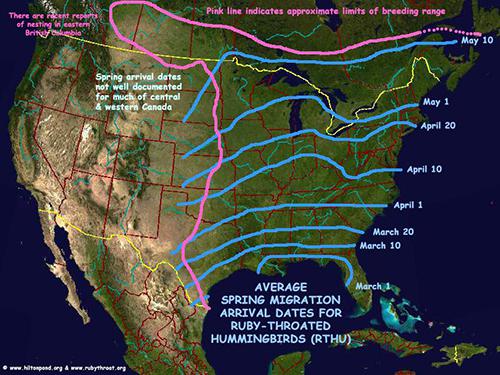
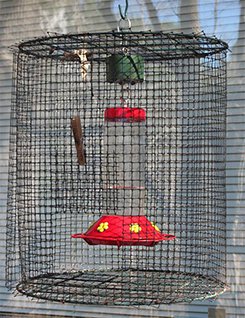
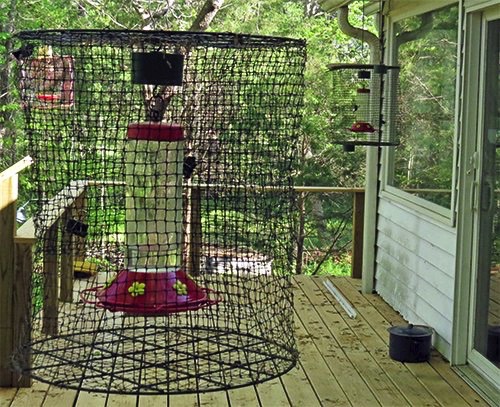
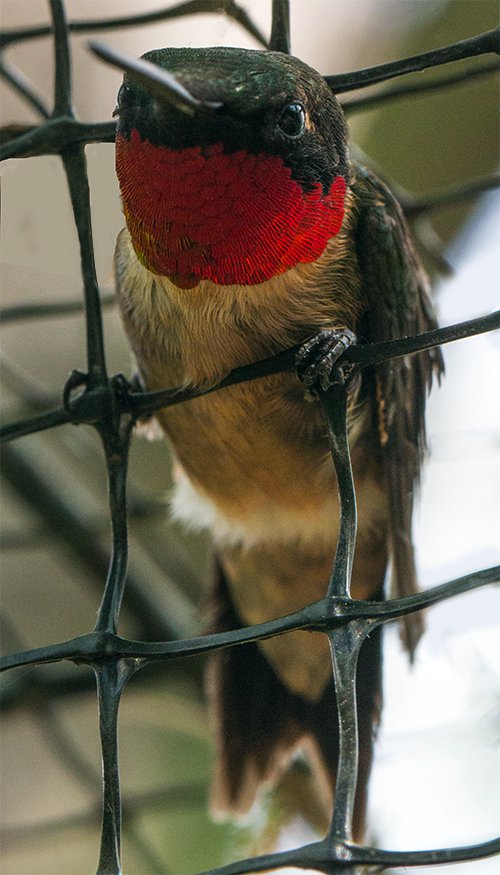
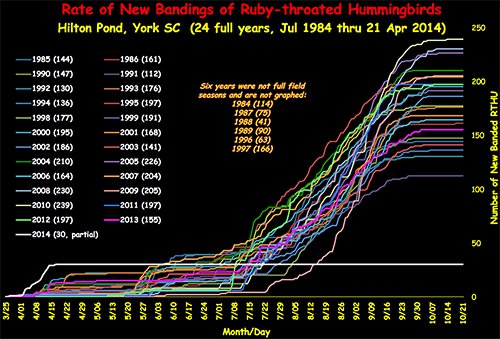
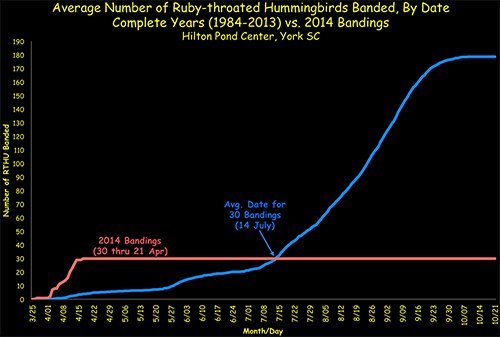
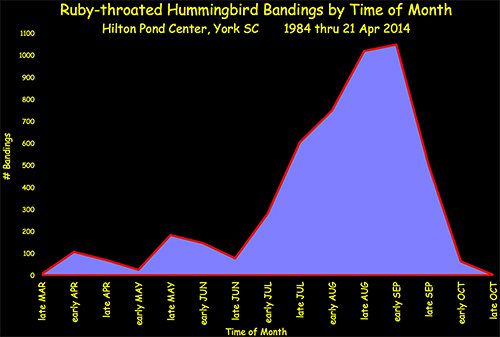
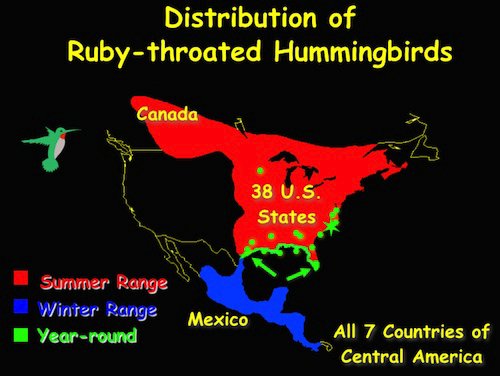
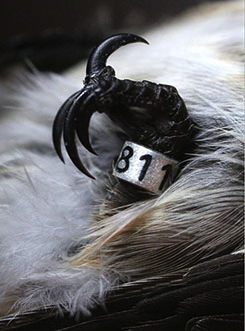 Until someone presents a different interpretation, we're sticking with our two-wave hypothesis and encourage homeowners to keep feeders fresh and not give up hope if they don't get hummers during the "first wave."
Until someone presents a different interpretation, we're sticking with our two-wave hypothesis and encourage homeowners to keep feeders fresh and not give up hope if they don't get hummers during the "first wave." 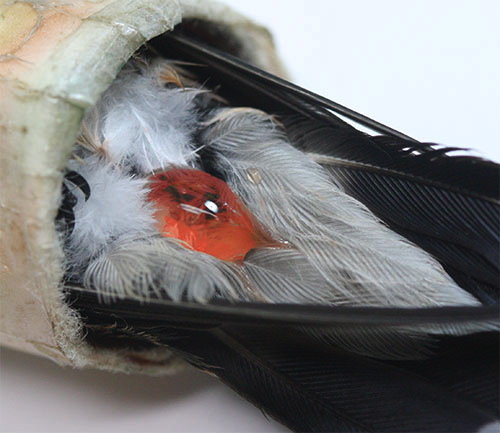
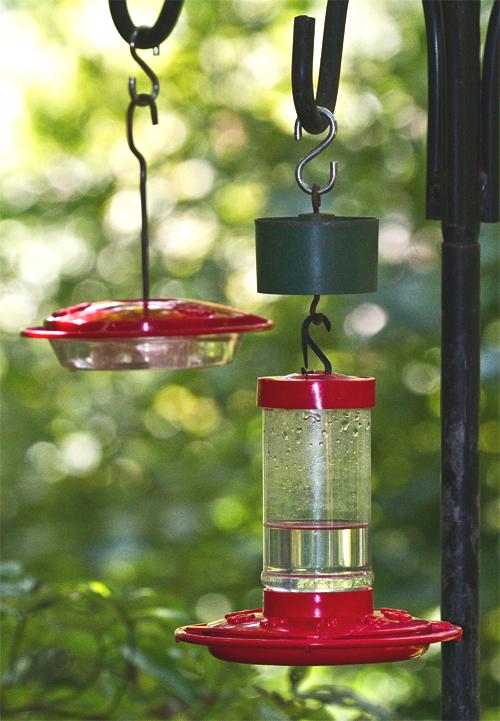 (For a minuscule bird like a hummer, it's possible red food coloring can be damaging to tiny kidneys, and the dye could even be toxic.)
(For a minuscule bird like a hummer, it's possible red food coloring can be damaging to tiny kidneys, and the dye could even be toxic.)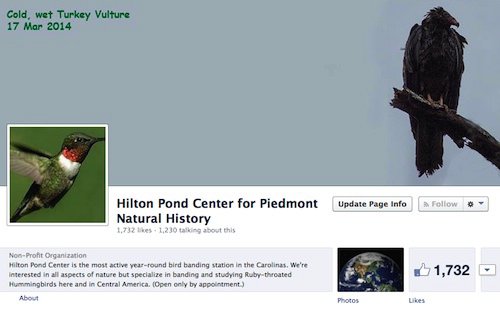
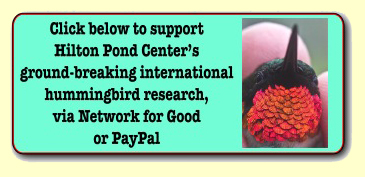







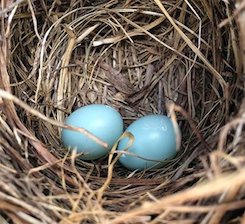
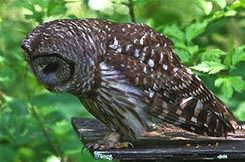
 Please report your
Please report your